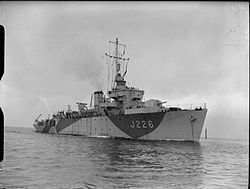 De Brouwer (M904) | |
| History | |
|---|---|
| Name | Spanker |
| Namesake | Spanker |
| Ordered | 15 November 1940 |
| Builder | Harland & Wolff, Belfast |
| Laid down | 22 September 1942 |
| Launched | 20 April 1943 |
| Commissioned | 20 August 1943 |
| Decommissioned | December 1947 |
| Identification | Pennant number: J226 |
| Fate | Sold to Belgium, 1953 |
| Name | De Brouwer |
| Namesake | De Brouwer |
| Acquired | 1953 |
| Commissioned | 25 February 1953 |
| Decommissioned | 1966 |
| Stricken | 1966 |
| Identification | Pennant number: M904 |
| Fate | Scrapped, 1967 |
| General characteristics | |
| Class & type | Algerine-class minesweeper |
| Displacement |
|
| Length | 225 ft (69 m) o/a |
| Beam | 35 ft 6 in (10.82 m) |
| Draught | 11 ft 6 in (3.51 m) |
| Installed power |
|
| Propulsion |
|
| Speed | 16.5 knots (30.6 km/h; 19.0 mph) |
| Range | 5,000 nmi (9,300 km; 5,800 mi) at 10 knots (19 km/h; 12 mph) |
| Complement | 85 |
| Armament | |
HMS Spanker (J226) was a steam turbine-powered Algerine-class minesweeper during the Second World War. She survived the war and was sold to Belgium in 1953 as De Brouwer (M904).
